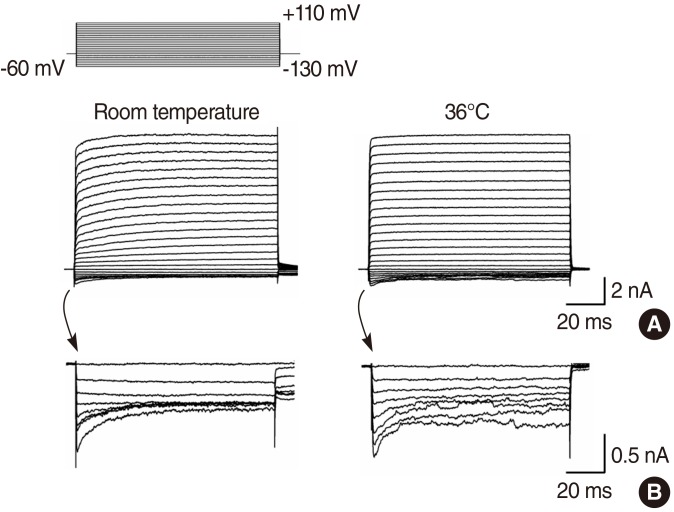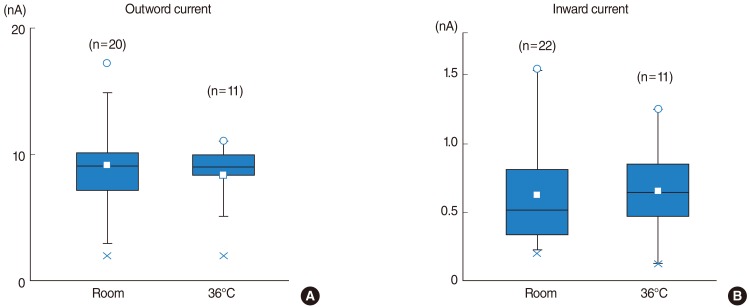1. Kros CJ, Crawford AC. Potassium currents in inner hair cells isolated from the guinea-pig cochlea. J Physiol. 1990; 2. 421:263–291. PMID:
2348394.

2. Marcotti W, Johnson SL, Holley MC, Kros CJ. Developmental changes in the expression of potassium currents of embryonic, neonatal and mature mouse inner hair cells. J Physiol. 2003; 4. 548(Pt 2):383–400. PMID:
12588897.

3. Kimitsuki T, Komune N, Noda T, Takaiwa K, Ohashi M, Komune S. Property of I
k, n in inner hair cells isolated from guinea-pig cochlea. Hear Res. 2010; 3. 261(1-2):57–62. PMID:
20060884.
4. Fernandez-Alfonso T, Ryan TA. The kinetics of synaptic vesicle pool depletion at CNS synaptic terminals. Neuron. 2004; 3. 41(6):943–953. PMID:
15046726.

5. Micheva KD, Smith SJ. Strong effects of subphysiological temperature on the function and plasticity of mammalian presynaptic terminals. J Neurosci. 2005; 8. 25(33):7481–7488. PMID:
16107635.

6. Nouvian R. Temperature enhances exocytosis efficiency at the mouse inner hair cell ribbon synapse. J Physiol. 2007; 10. 584(Pt 2):535–542. PMID:
17717016.

7. Sanz AG, Hospital S, Badia A, Clos MV. Presynaptic effect of 7-OH-DPAT on evoked [3H]-acetylcholine release in rat striatal synaptosomes. Brain Res. 2000; 8. 874(2):116–122. PMID:
10960595.

8. Sumners C, Fleegal MA, Zhu M. Angiotensin AT1 receptor signalling pathways in neurons. Clin Exp Pharmacol Physiol. 2002; May-Jun. 29(5-6):483–490. PMID:
12010196.

9. He DZ, Zheng J, Edge R, Dallos P. Isolation of cochlear inner hair cells. Hear Res. 2000; 7. 145(1-2):156–160. PMID:
10867288.

10. Santos-Sacchi J, Huang GJ, Wu M. Mapping the distribution of outer hair cell voltage-dependent conductances by electrical amputation. Biophys J. 1997; 9. 73(3):1424–1429. PMID:
9284309.

11. Hille B. Potassium channels and chloride channels. In : Hille B, editor. Ionic channels of excitable membranes. 2nd ed. Sunderland, MA: Sinauer;1991. p. 115–139.
12. Kimitsuki T, Ohashi M, Wada Y, Fukudome S, Komune S. Inactivating and non-inactivating potassium currents in isolated inner hair cells from guinea pig cochlea. Acta Otolaryngol Suppl. 2004; 8. (553):28–32. PMID:
15277032.

13. Mitsuiye T, Shinagawa Y, Noma A. Temperature dependence of the inward rectifier K
+ channel gating in guinea-pig ventricular cells. Jpn J Physiol. 1997; 2. 47(1):73–79. PMID:
9159645.
14. Beam KG, Donaldson PL. A quantitative study of potassium channel kinetics in rat skeletal muscle from 1 to 37 degrees C. J Gen Physiol. 1983; 4. 81(4):485–512. PMID:
6304231.

15. Pahapill PA, Schlichter LC. Modulation of potassium channels in human T lymphocytes: effects of temperature. J Physiol. 1990; 3. 422:103–126. PMID:
2352174.

16. Brandt A, Khimich D, Moser T. Few CaV1.3 channels regulate the exocytosis of a synaptic vesicle at the hair cell ribbon synapse. J Neurosci. 2005; 12. 25(50):11577–11585. PMID:
16354915.

17. Johnson SL, Marcotti W. Biophysical properties of CaV1.3 calcium channels in gerbil inner hair cells. J Physiol. 2008; 2. 586(4):1029–1042. PMID:
18174213.

18. Kros CJ, Ruppersberg JP, Rusch A. Expression of a potassium current in inner hair cells during development of hearing in mice. Nature. 1998; 7. 394(6690):281–284. PMID:
9685158.

19. Bregestovski P, Redkozubov A, Alexeev A. Elevation of intracellular calcium reduces voltage-dependent potassium conductance in human T cells. Nature. 1986; Feb-Mar. 319(6056):776–778. PMID:
2419761.

20. Choquet D, Sarthou P, Primi D, Cazenave PA, Korn H. Cyclic AMPmodulated potassium channels in murine B cells and their precursors. Science. 1987; 3. 235(4793):1211–1214. PMID:
2434998.

21. Armstrong CE, Roberts WM. Rapidly inactivating and non-inactivating calcium-activated potassium currents in frog saccular hair cells. J Physiol. 2001; 10. 536(Pt 1):49–65. PMID:
11579156.

22. Ding JP, Li ZW, Lingle CJ. Inactivating BK channels in rat chromaffin cells may arise from heteromultimeric assembly of distinct inactivation-competent and noninactivating subunits. Biophys J. 1998; 1. 74(1):268–289. PMID:
9449328.







 PDF
PDF Citation
Citation Print
Print






 XML Download
XML Download